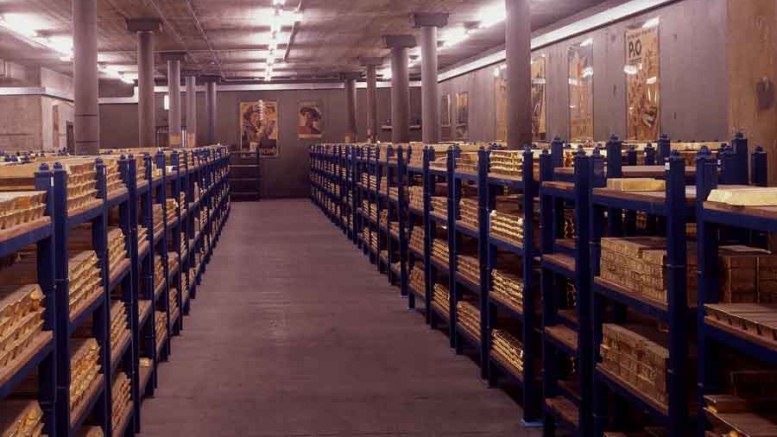Gold market consulting firm Thomson Reuters GFMS is calling for renewed strength in the bull market for gold in the year ahead. The prediction came as GFMS unveiled the second update to its Gold Survey 2012 at a presentation in mid-January in Toronto, where Philip Klapwijk, GFMS’s global head of metals analytics, said that macroeconomic conditions and central bank buying would continue to drive gold prices higher to an average of US$1,847 per oz. in 2013, and an average of US$1,775 per oz. in the first half of the year.
According to Klapwijk, loose monetary policies by central banks combined with negative real interest rates will continue to push investor demand for gold.
“Recent years’ leg-up in gold prices has been assisted, at least, by the fact that short term interest rates have moved quite deeply into negative territory over the last few years,” Klapwijk said. He expects these conditions to continue in the medium-term, which, in his view, will support higher prices.
A major factor on the demand side of the equation is ongoing net purchases of gold by central banks. In 2012, central banks bought an estimated 536 tonnes of gold (17.2 million oz.), in contrast to 2003 when they sold approximately 500 tonnes — a difference of more than a 1,000 tonnes from 10 years earlier.
Moreover, last year’s purchases marked a 79 tonne (2.5 million oz.), or 17.4 %, increase over 2011, a trend Klapwijk said is likely to continue, forecasting a 1.2% increase in official sector purchases in the first half of 2013.
Klapwijk expects further downgrades of sovereign debt ratings in Europe and warned of major implications in the event of a downgrade of the United States’ credit rating from AAA, describing the U.S. fiscal situation as a “train wreck about to happen.”
“I can only see that this has to end in a U.S. downgrade, which is being totally, in my view, underplayed by the analytical community,” Klapwijk said. “After all, what are we going to see here? The biggest safe haven market in the world will have its triple A status removed. If this isn’t going to be a boost to gold, what will be?”
GFMS reported a modest gain of 6 tonnes, or 0.2%, in mine production to 2,842 tonnes (91.37 million oz.) in 2012; nevertheless, it still marked an all-time annual record.
China had the largest increase, adding nearly 40 tonnes over 2011 production, followed by Russia (10 tonnes), Mexico (5 tonnes) and Ghana (5 tonnes). The biggest decline occurred in Indonesia, down 25 tonnes, followed by South Africa (22 tonnes), Australia (10 tonnes) and Kyrgyzstan (9 tonnes).
Klapwijk noted that scrap supply was down 1.6%, while total supply fell 1%, “perhaps a surprising outcome considering the level of gold prices.”
The report confirmed that production costs have been rising — a familiar theme for anyone following underperforming mining companies in 2012 — and that this is resulting in less-than-expected profits for much of the sector.
In regard to costs, the research group adopted two separate metrics for measuring the expenses associated with gold production: “total cash costs,” a commonly used measure of the cost to produce an ounce of gold; and “all-in costs,” a newer metric that includes amortizations, depreciation, sustaining capital and royalties. Klapwijk described the total cash costs metric as increasingly “irrelevant” because of the expenses it ignores, arguing that all-in costs are a more meaningful assessment. (In January, blue chip miner Goldcorp (G-T, GG-N) announced that it is adding an “all-in” metric to its financial statements, citing the need for a more accurate gauge.)
GFMS reports that total cash costs averaged US$740 per oz. in 2012, while all-in costs were US$1,150 per oz., and it anticipates that rising expenses related to mining production were likely to continue.
World gold investment in 2012 was about 1,600 tonnes (51 million oz.), which set a new record in value terms, amounting to a net US$87 billion in investment.
Indian jewelry demand declined in 2012, which is largely attributed to the fact that gold prices measured in rupees rose. Nevertheless, Klapwijk expects demand to stabilize in 2013, noting that the 2013 Indian wedding season has several more astrologically favourable wedding days than 2012, which could result in more marriages taking place.
Although Klapwijk expects supply to keep growing in 2013, he believes central bank purchases and investment demand will trump any potential market surpluses, emphasizing the continued “lack of faith in major global currencies.”
“We think we could get a touch of US$2,000 per oz. during the course of this year,” Klapwijk said.


Be the first to comment on "GFMS sees higher gold prices in 2013"